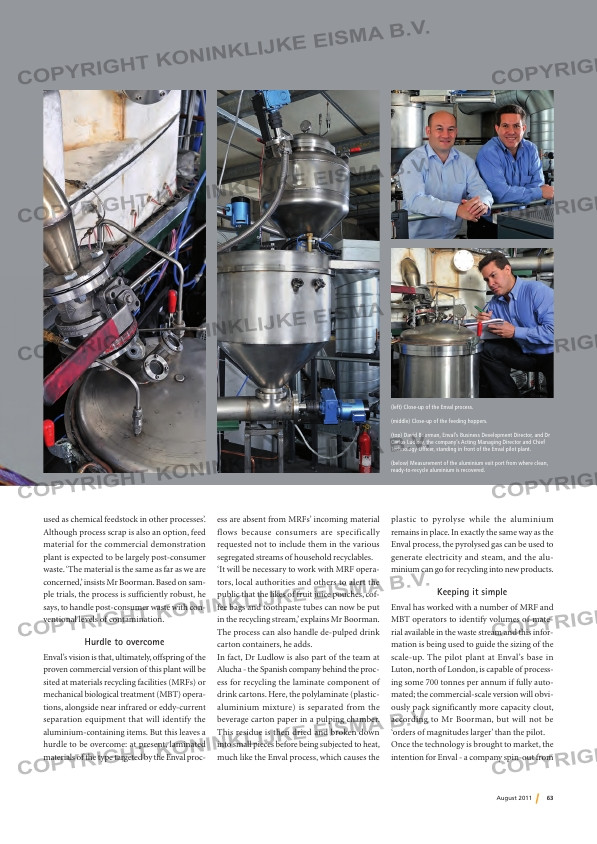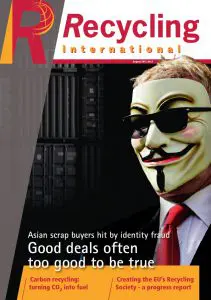Page 63 from: August 2011

63August 2011
used as chemical feedstock in other processes’.
Although process scrap is also an option, feed
material for the commercial demonstration
plant is expected to be largely post-consumer
waste. ‘The material is the same as far as we are
concerned,’ insists Mr Boorman. Based on sam-
ple trials, the process is sufficiently robust, he
says, to handle post-consumer waste with con-
ventional levels of contamination.
Hurdle to overcome
Enval’s vision is that, ultimately, offspring of the
proven commercial version of this plant will be
sited at materials recycling facilities (MRFs) or
mechanical biological treatment (MBT) opera-
tions, alongside near infrared or eddy-current
separation equipment that will identify the
aluminium-containing items. But this leaves a
hurdle to be overcome: at present, laminated
materials of the type targeted by the Enval proc-
ess are absent from MRFs’ incoming material
flows because consumers are specifically
requested not to include them in the various
segregated streams of household recyclables.
‘It will be necessary to work with MRF opera-
tors, local authorities and others to alert the
public that the likes of fruit juice pouches, cof-
fee bags and toothpaste tubes can now be put
in the recycling stream,’ explains Mr Boorman.
The process can also handle de-pulped drink
carton containers, he adds.
In fact, Dr Ludlow is also part of the team at
Alucha – the Spanish company behind the proc-
ess for recycling the laminate component of
drink cartons. Here, the polylaminate (plastic-
aluminium mixture) is separated from the
beverage carton paper in a pulping chamber.
This residue is then dried and broken down
into small pieces before being subjected to heat,
much like the Enval process, which causes the
plastic to pyrolyse while the aluminium
remains in place. In exactly the same way as the
Enval process, the pyrolysed gas can be used to
generate electricity and steam, and the alu-
minium can go for recycling into new products.
Keeping it simple
Enval has worked with a number of MRF and
MBT operators to identify volumes of mate-
rial available in the waste stream and this infor-
mation is being used to guide the sizing of the
scale-up. The pilot plant at Enval’s base in
Luton, north of London, is capable of process-
ing some 700 tonnes per annum if fully auto-
mated; the commercial-scale version will obvi-
ously pack significantly more capacity clout,
according to Mr Boorman, but will not be
‘orders of magnitudes larger’ than the pilot.
Once the technology is brought to market, the
intention for Enval – a company spin-out from
(left) Close-up of the Enval process.
(middle) Close-up of the feeding hoppers.
(top) David Boorman, Enval’s Business Development Director, and Dr
Carlos Ludlow, the company’s Acting Managing Director and Chief
Technology Offi cer, standing in front of the Enval pilot plant.
(below) Measurement of the aluminium exit port from where clean,
ready-to-recycle aluminium is recovered.
p062_Laminated packaging.indd 63 10-08-11 10:02



